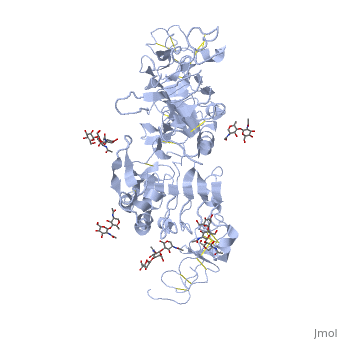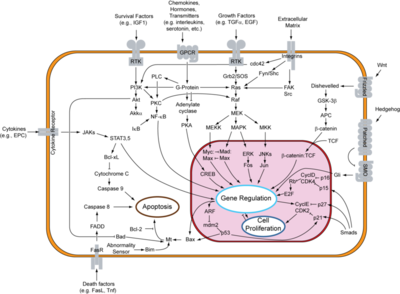Epidermal Growth Factor Receptor
From Proteopedia
(Difference between revisions)
| (5 intermediate revisions not shown.) | |||
| Line 6: | Line 6: | ||
[[Epidermal Growth Factor Receptor]] (EGFR or '''ERBB1''') is found on the cell surface and associates to homodimers upon binding of its ligands such as the Epidermal Growth Factor (EGF) to its extracellular domain. The dimerization stimulates autophosphorylation of several tyrosine residues in the intracellular kinase domain which signal downstream transduction cascades. A human '''EGFR-2 (HER-2 or ERBB2)''' is involved in breast [[Cancer|cancer]] and is a major target for breast cancer [[Pharmaceutical Drugs|therapeutics]]. See more details in [[Herceptin - Mechanism of Action]]. '''ERBB3''' uses neuregulin as a ligand. '''ERBB4''' is a closely related [[Receptor tyrosine kinases|receptor tyrosine kinase]]. | [[Epidermal Growth Factor Receptor]] (EGFR or '''ERBB1''') is found on the cell surface and associates to homodimers upon binding of its ligands such as the Epidermal Growth Factor (EGF) to its extracellular domain. The dimerization stimulates autophosphorylation of several tyrosine residues in the intracellular kinase domain which signal downstream transduction cascades. A human '''EGFR-2 (HER-2 or ERBB2)''' is involved in breast [[Cancer|cancer]] and is a major target for breast cancer [[Pharmaceutical Drugs|therapeutics]]. See more details in [[Herceptin - Mechanism of Action]]. '''ERBB3''' uses neuregulin as a ligand. '''ERBB4''' is a closely related [[Receptor tyrosine kinases|receptor tyrosine kinase]]. | ||
| - | See also [[Kinase-linked, enzyme-linked and related receptors]]. | + | See also [[Kinase-linked, enzyme-linked and related receptors]] and [[EGFR Inhibitors]]. |
==Relevance== | ==Relevance== | ||
| - | [[Lapatinib]] is | + | [[Lapatinib]] is an EGFR inhibitor used in breast cancer treatment. ERBB2 is necessary for heart cells proliferation and regeneration<ref>PMID:25848746</ref>. [[Afatinib]] is an EGFR inhibitor used in treatment of non-small cell lung carcinoma. |
==EGFR and Lung Cancer== | ==EGFR and Lung Cancer== | ||
| Line 21: | Line 21: | ||
Tyrosine kinases in general control critical cellular activities through regulation of signal pathways <ref name='pao'>pmid 15329413</ref>. This regulation is essential for controlling the cell and making sure it acts normally and goes through the normal cell cycle. However, when these kinases are mutated, they can lead to cancer as a result <ref name='pao'/>. Mutations in EGFR as a result can also lead to cancers, and this is why understanding how EGFR works is an essential aspect for the treatment of certain cancers. In cancer, cells divide rapidly without control and an uncontrolled or unregulated EGF receptor will and can result in uncontrolled cell division. Therefore, inhibition of EGFR can be an essential part of controlling cancers caused by mutations in EGFR. | Tyrosine kinases in general control critical cellular activities through regulation of signal pathways <ref name='pao'>pmid 15329413</ref>. This regulation is essential for controlling the cell and making sure it acts normally and goes through the normal cell cycle. However, when these kinases are mutated, they can lead to cancer as a result <ref name='pao'/>. Mutations in EGFR as a result can also lead to cancers, and this is why understanding how EGFR works is an essential aspect for the treatment of certain cancers. In cancer, cells divide rapidly without control and an uncontrolled or unregulated EGF receptor will and can result in uncontrolled cell division. Therefore, inhibition of EGFR can be an essential part of controlling cancers caused by mutations in EGFR. | ||
| - | [[Gefitinib]] is an inhibitor of EGFR, and it is used to treat some cancers especially non-small cell lung cancers (NSCLC) <ref name='pao'/>. If one is able to inhibit the ability of EGF to bind to its receptor, one can control the rate of cell division in tumor cells caused by mutations or problems in EGFR. | + | [[Gefitinib]] is an inhibitor of EGFR, and it is used to treat some cancers especially non-small cell lung cancers (NSCLC) <ref name='pao'/>. If one is able to inhibit the ability of EGF to bind to its receptor, one can control the rate of cell division in tumor cells caused by mutations or problems in EGFR. [[Gefitinib]] binds to EGFR at its highly important ATP binding activation site which is located at lysine 745 <ref name='pao'/>. When [[Gefitinib]] binds to this ATP binding site, it obviously does not allow for ATP to attach and phosphorylate in order to activate EGFR (<scene name='Yousuf_Bahrami_sandbox_1/Egfr_binded_to_gefitinib/1'>Gefitinib bound to EGFR</scene>). If ATP cannot bind, less EGF receptors will be activated and therefore this should help inhibit cell division in tumor cells and even cause regression. According to a study with two phase trials, regression of tumors were found in 28% of patients treated in Japan and 10% of those treated in Europe and U.S.A. <ref name='pao'/>. |
The real question to answer was why is [[Gefitinib]] effective against some tumors and not against others. Through studying ten patients who showed response to gefitinib, 70% had mutations in exons 18-24 of EGFR using mutational profiling of exons 18-24 <ref name='pao'/>. Of these 7 patients, six showed the exact same mutation at the critical ATP binding site of K745 (<scene name='Yousuf_Bahrami_sandbox_1/K745/1'>See K745</scene>) while the other patient showed a L858R mutation (<scene name='Yousuf_Bahrami_sandbox_1/858/1'>See L858</scene>) <ref name='pao'/>. These two mutations seem to be the two prevalent mutations seen in patients that have shown responses to [[Gefitinib]]. Through studying 8 refractory tumors not affected by [[Gefitinib]], none of the eight showed any mutations in exons 18-24 of EGFR <ref name='pao'/>. This shows the connection between a mutation in EGFR and its ability to be treated by [[Gefitinib]] which binds to the critical ATP binding site. Many of these mutations occurred at the same ATP binding site. Another drug, [[Erlotinib]], showed almost exactly the same results as [[Gefitinib]] <ref name='pao'/>. | The real question to answer was why is [[Gefitinib]] effective against some tumors and not against others. Through studying ten patients who showed response to gefitinib, 70% had mutations in exons 18-24 of EGFR using mutational profiling of exons 18-24 <ref name='pao'/>. Of these 7 patients, six showed the exact same mutation at the critical ATP binding site of K745 (<scene name='Yousuf_Bahrami_sandbox_1/K745/1'>See K745</scene>) while the other patient showed a L858R mutation (<scene name='Yousuf_Bahrami_sandbox_1/858/1'>See L858</scene>) <ref name='pao'/>. These two mutations seem to be the two prevalent mutations seen in patients that have shown responses to [[Gefitinib]]. Through studying 8 refractory tumors not affected by [[Gefitinib]], none of the eight showed any mutations in exons 18-24 of EGFR <ref name='pao'/>. This shows the connection between a mutation in EGFR and its ability to be treated by [[Gefitinib]] which binds to the critical ATP binding site. Many of these mutations occurred at the same ATP binding site. Another drug, [[Erlotinib]], showed almost exactly the same results as [[Gefitinib]] <ref name='pao'/>. | ||
| Line 34: | Line 34: | ||
* [[Gefitinib]] or Iressa<br /> | * [[Gefitinib]] or Iressa<br /> | ||
* [[Erlotinib]] or Tarceva<br /> | * [[Erlotinib]] or Tarceva<br /> | ||
| + | EGFR inhibitors used in non-small cell lung cancer treatment<br /> | ||
| + | * [[Osimertinib]] or Tagrisso<br /> | ||
EGFR inhibitors used in renal cell carcinoma and kidney cancer treatment<br /> | EGFR inhibitors used in renal cell carcinoma and kidney cancer treatment<br /> | ||
* [[Sorafenib]] or Nexavar<br /> | * [[Sorafenib]] or Nexavar<br /> | ||
Current revision
| |||||||||||
Additional Resources
For additional information, see: Cancer
References
- ↑ D'Uva G, Aharonov A, Lauriola M, Kain D, Yahalom-Ronen Y, Carvalho S, Weisinger K, Bassat E, Rajchman D, Yifa O, Lysenko M, Konfino T, Hegesh J, Brenner O, Neeman M, Yarden Y, Leor J, Sarig R, Harvey RP, Tzahor E. ERBB2 triggers mammalian heart regeneration by promoting cardiomyocyte dedifferentiation and proliferation. Nat Cell Biol. 2015 May;17(5):627-38. doi: 10.1038/ncb3149. Epub 2015 Apr 6. PMID:25848746 doi:http://dx.doi.org/10.1038/ncb3149
- ↑ 2.0 2.1 Sherrill JM, Kyte J. Activation of epidermal growth factor receptor by epidermal growth factor. Biochemistry. 1996 May 7;35(18):5705-18. doi: 10.1021/bi9602268. PMID:8639530 doi:http://dx.doi.org/10.1021/bi9602268
- ↑ 3.0 3.1 Herbst RS. Review of epidermal growth factor receptor biology. Int J Radiat Oncol Biol Phys. 2004;59(2 Suppl):21-6. doi:, 10.1016/j.ijrobp.2003.11.041. PMID:15142631 doi:http://dx.doi.org/10.1016/j.ijrobp.2003.11.041
- ↑ 4.00 4.01 4.02 4.03 4.04 4.05 4.06 4.07 4.08 4.09 4.10 Pao W, Miller V, Zakowski M, Doherty J, Politi K, Sarkaria I, Singh B, Heelan R, Rusch V, Fulton L, Mardis E, Kupfer D, Wilson R, Kris M, Varmus H. EGF receptor gene mutations are common in lung cancers from "never smokers" and are associated with sensitivity of tumors to gefitinib and erlotinib. Proc Natl Acad Sci U S A. 2004 Sep 7;101(36):13306-11. doi:, 10.1073/pnas.0405220101. Epub 2004 Aug 25. PMID:15329413 doi:http://dx.doi.org/10.1073/pnas.0405220101
Proteopedia Page Contributors and Editors (what is this?)
Michal Harel, David Canner, Alexander Berchansky, Joel L. Sussman, Jaime Prilusky


